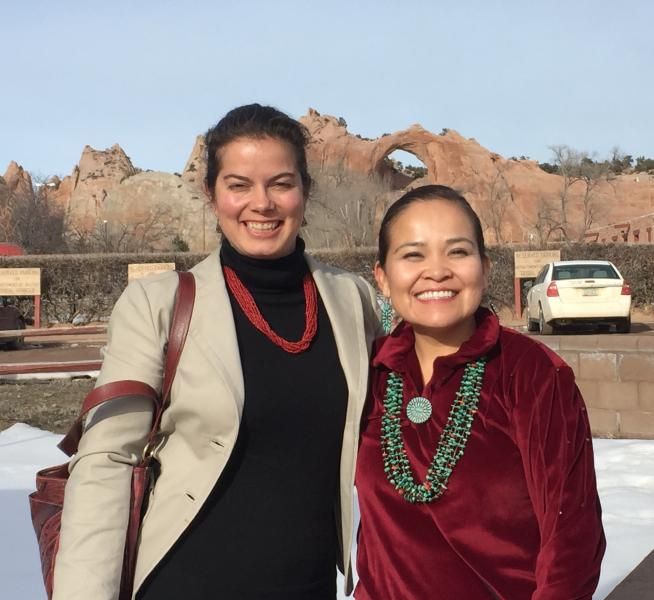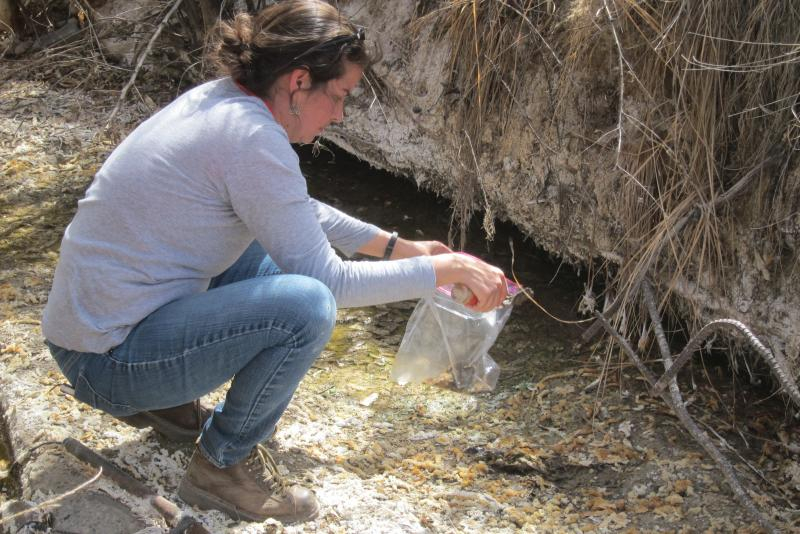From left, University of Arizona researchers Paloma Beamer (Mel and Enid Zuckerman College of Public Health) and Karletta Chief (Department of Soil, Water and Environmental Sciences) in Window Rock, AZ.
The University of Arizona Mel and Enid Zuckerman College of Public Health and the Department of Soil, Water and Environmental Science received a $434,000 grant from the National Institute of Environmental Health Sciences (NIEHS) to investigate the effects of the Gold King Mine spill on Navajo lands.
A cross-disciplinary team of researchers from the University of Arizona are investigating short term exposure in Navajo communities after the Gold King Mine toxic spill last year. The important study is expected to address tribal questions regarding the impact of the environmental disaster on their communities.
Approximately 3 million gallons of acid water and heavy metals from the Gold King Mine poured into Colorado’s Animas River on Aug. 5, 2015. The water flowed into the San Juan River, the primary source of irrigation for Navajo Nation farmers. The spill was caused accidentally by the U.S. Environmental Protection Agency (EPA) while trying to prevent leakage of toxic materials.
A Los Angeles Times article called it one of the biggest environmental disasters in the region occurring in the middle of growing season for hay and alfalfa. One of the largest Navajo chapters voted to keep their gates closed for at least a year to avoid contaminating the soil and to protect the seeds they have held in their families for generations.
The UA has received a $434,000 grant from the National Institute of Environmental Health Sciences (NIEHS) to investigate the effects of the Gold King Mine spill on Navajo lands. Leading the investigation are Karletta Chief, PhD, a Navajo hydrologist and assistant professor in the UA Department of Soil, Water and Environmental Sciences at the UA College of Agriculture and Life Sciences, and Paloma Beamer, PhD, associate professor of environmental health sciences in the UA Mel and Enid Zuckerman College of Public Health. Both Drs. Chief and Beamer are Superfund Research Program investigators. The NIEHS grant supports a team of researchers from the UA, Northern Arizona University and Navajo community health representatives.
Dr. Chief says leakage from abandoned mines upstream is a constant threat and the project will work towards understanding the exposures Navajos face.
“To the Navajo people, water is sacred. The land they live on is their identity and their livelihood. Their world view is based on Mother Earth and Father Sky. The impact of this spill cut deep to the core of these spiritual and traditional values. At the same time, there is little data that provides answers to Navajo concerns regarding the potential exposures they face as result of this contamination,” said Dr. Chief.
The investigators will determine differences in exposures between three Navajo communities downstream of the Gold King Mine spill; Upper Fruitland and Shiprock in New Mexico and Aneth in Utah. They will assess changes in sediment, agricultural soil, and river and irrigation water.
“Even though there are tens of thousands of abandoned mines throughout the United States, the catastrophic Gold King Mine spill has highlighted how little empirical data exists regarding potential community exposures and long-term health impacts after such an event,” said Dr. Beamer added.
“Results from this study have the potential to inform risk communication and intervention strategies in the unfortunate event of future mine spills, particularly in Native American communities. We are also working with Navajo students and community members to carry out this research and increase tribal capacity.”
The study received approval by the Navajo Nation Human Research Review Board. Project leaders Drs. Chief and Beamer are coordinating their sampling efforts with the Navajo Environmental Protection Agency, Navajo Division of Natural Resources and Navajo Tribal Utility Authority.
The team of co-investigators working with Drs. Beamer and Chief include: Nicolette Teufel-Shone, PhD, professor of health promotion sciences, and Dean Billheimer, PhD, professor of biostatistics, with the UA Mel and Enid Zuckerman College of Public Health; Jani Ingram, PhD, Navajo professor of analytical chemistry, and Manley Begay, EdD, Navajo professor of Applied Indigenous Studies with NAU. Students and interns from UA, NAU, Diné College, and the Bureau of Indian Affairs Native American Water Corps program will be working out in the field collecting soil samples.










